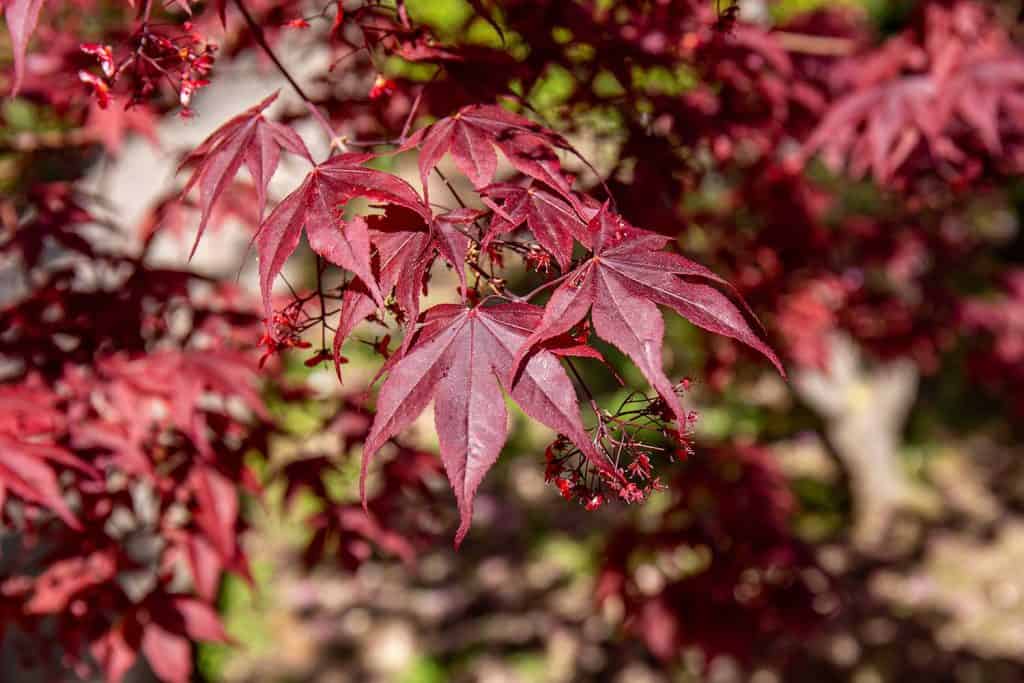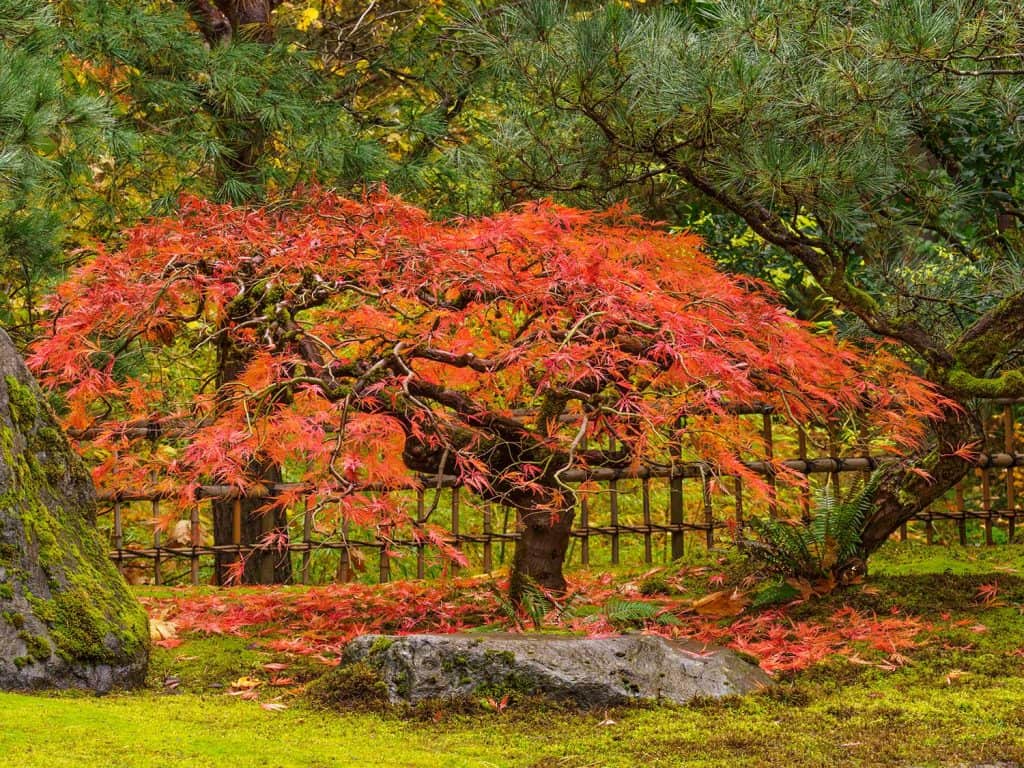Maple trees are easily recognizable. They have distinct leaves that color beautifully in the fall seasons. These trees are excellent choices to add to a home garden. If you're looking for a maple tree, then you'll need to know how to care for it. One of the most basic things to know is how much light your tree needs to get. We've done the research and can tell you how much sun different types of maples trees need.
Maples trees need full to partial sunlight depending on the climate of their location. A maple tree in a colder region will need more sunlight than a hotter area. At the minimum, a maple tree should be getting four hours of sunlight.
Keep reading to learn sunlight requirements for popular types of maples trees, ideal conditions for this tree, and more.
![A red maple tree in the fall, Do Maple Trees Need Full Sun? [By Type Of Maple]](https://gardentabs.com/wp-content/uploads/2021/07/Do-Maple-Trees-Need-Full-Sun-683x1024.png)
Sun Requirements for Maple Trees
In general, maple trees enjoy full to partial sun or partial shade. Full sun means that your plant or tree needs a minimum of six hours of sunlight a day. While 6 hours is the minimum, plants needing full sun will often do fine with 8 to 10 hours of sun.
Partial sun and partial shade are a little ambiguous. Plants and trees with these requirements will need anywhere from three to six hours of sunlight a day. However, a plant that requires partial sun is generally more heat tolerant. These will most likely need more than four hours of sun and will be more resistant to afternoon heat.
In comparison, partial shade suggests that you should shade the tree from the afternoon sun. These plants should also be able to thrive on less than four hours of sunlight.
By USDA Hardiness Zones
You may need to adjust the amount of sun your maple gets depending on the region you live in. Eight hours of direct sunlight in Dallas isn't the same as eight hours of sunlight in Denver. Both these places fall within the recommended hardiness zone. However, a tree in the southern hardiness zones, like Dallas, will need more protection from the sun than those in the northern regions.
By Types of Maple
While many types of maple trees have common needs, something that works for one species won't necessarily work for another. Here are some common features and sun requirements of popular types of maple trees.
Japanese Red Maple

Acer palmatum or the Japanese maple grows naturally in a shady environment. This species of maple is best suited for USDA hardiness zones five through eight. Although, with proper care, they can be grown in warmer conditions. Japanese red maples should receive partial sunlight.
Sugar Maple
The sugar maple or Acer saccharum is most well known for being the primary source of maple syrup. Before the rise of car pollution, the sugar maple was also the go-to tree for decorating parks and streets. These trees are fairly tolerant of shade and grow in zones three through eight.
Red Maple
Acer rubrum or red maple is one of the most common types of maple trees. These trees are fast-growing and provide excellent yellow to red leaf color in the fall. Red maple trees prefer full sunlight.
Silver Maple
Silver maple, known scientifically as the Acer saccharinum, is one of the fastest-growing maple trees. Their growth speed means that they will provide shade sooner than other plants. However, its quick growth means that this tree is prone to breaking in high winds. Silver maples prefer partial shade conditions. Aim to give your tree four hours of direct sunlight.
Boxelder Maple
Acer negundo or boxelder maple is a short-lived tree that only survives around 60 years. The leaves of a boxelder maple look similar to the leaves of poison ivy. This is why it's sometimes referred to as the poison ivy tree. Boxelders can be invasive. They easily germinate and can quickly vegetate if present. These trees require full sunlight and should get at least six hours a day.
Bigleaf Maple
Out of all the maple trees, the bigleaf maple, Acer macrophyllum, has the largest leaves. In the fall, the leaves turn to gold and yellow before falling off. In the spring, bigleaf maples flower before the leaves appear. Bigleaf maples prefer open areas. While they are tolerant of shade, this tolerance decreases as the tree ages. Aim to give this plant six hours of sun per day.
Amur Maple
The Amur maple, Acer ginnala, is the most cold-tolerant of maple trees. While best planted in hardiness zones three through eight, it can tolerate winters in zone 2. Hardiness zone 2 includes places such as Alaska, Montana, and Michigan. This type of tree is especially vibrant and has bright shades of red and orange leaves. Your amur maple will do best if given six hours of light per day.
Paperback Maple
Acer griseum, commonly called the paperback maple, is an excellent choice for landscaping. These maples have bright red leaves in the fall. The bark also gets a distinctive look with age. The older top layer of bark often peels away to show the young bark underneath. These trees do well with six hours of full sunlight.
What conditions do maple trees like?
For the most part, maple trees enjoy moderate to cooler temperatures. Well-filtered soil is also critical to maple trees. Very few species of maple are capable of surviving in dry or waterlogged soil. Specific temperature and soil requirements will vary by species of maple.
Full sun to partial shade is also a common need for maple trees. Many maples will require at least six hours of direct sunlight a day. When first growing, maples tend to be more tolerant of shade. As they grow and get older, this tolerance drops. When planning your garden, make sure you consider how much light your plants will get during different seasons and different parts of the day. This will help you provide the proper amount of light year-round.
Do Japanese maples need sun or shade?

Since Japanese maples are naturally found in the understory of forests, these trees prefer shadier conditions. Try to give your Japanese maple around four hours of sunlight each day. However, avoid the afternoon sun. While the Japanese maple is considered heat-tolerant, the sun can still cause the leaves to scorch, especially in hotter climates.
How much sun does a sugar maple need?
A sugar maple tree is a great choice for landscaping. The leaves on this tree turn to beautiful yellows, oranges, and reds during the fall seasons. While sugar maples are fairly tolerant of shady conditions, they still prefer full sun. Aim to give this tree at least four hours of direct sunlight per day.
How much sun does a red maple need?
Red maple trees provide pops of color throughout the year. While the leaves are green except for the fall, the red maple will produce red and yellow flowers from winter to spring. In the fall, the leaves will turn a yellow to red color. These bright trees need at least six hours of sunlight a day.
Do maple seedlings need shade or sun?
Maple seedlings will do best in shadier conditions. Make sure to protect your seedlings from the harsh afternoon sun. This is especially true for Japanese maples, which are especially prone to leaf scorches. Using a shade cloth will help protect your seedling while still allowing it natural light. You can easily remove this cloth once your tree is more established.
Check out this garden shade cloth on Amazon.
In Closing
Maple trees have beautiful and distinct vibrant colors. While specifics will vary slightly based on tree species, many maples prefer partial shade to full sunlight conditions. This means that maple trees should get four hours of sun at a minimum, with some needing around six hours. Remember to adjust your sunlight needs based on your hardiness zone and climate. Sometimes high heat from the sun can cause leaves to scorch.
You may also enjoy:

